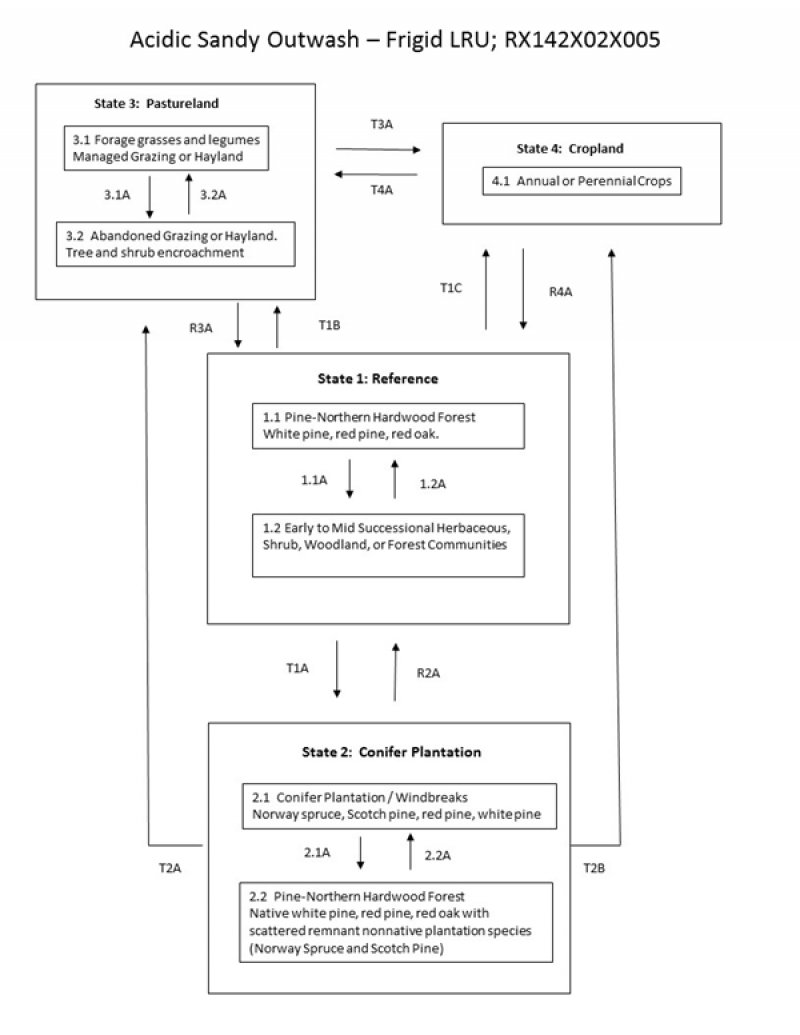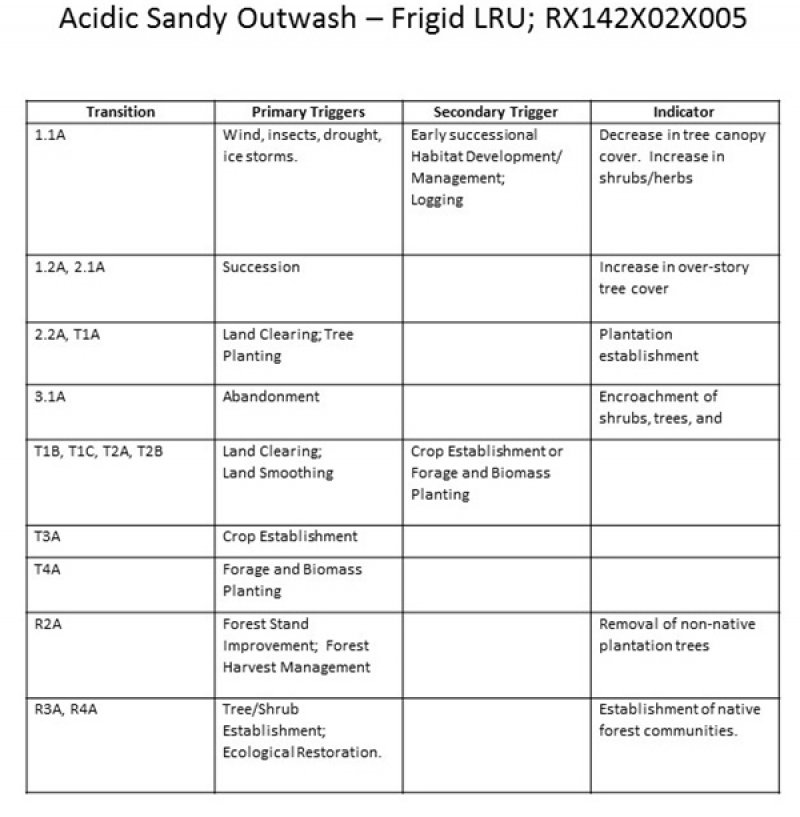
Natural Resources
Conservation Service
Ecological site F142XA005NY
Acidic Sandy Outwash
Last updated: 10/03/2024
Accessed: 04/29/2025
General information
Provisional. A provisional ecological site description has undergone quality control and quality assurance review. It contains a working state and transition model and enough information to identify the ecological site.
MLRA notes
Major Land Resource Area (MLRA): 142X–St. Lawrence-Champlain Plain
This MLRA is a glaciated area of low relief dominated by broad expanses of nearly level, sandy deltas and shallow lacustrine basins or plains punctuated by low hills of glacial till. Rivers and streams have cut relatively deep but narrow valleys across the plain. Elevation ranges from 80 to 1,000 feet, increasing gradually from the St. Lawrence River southward and from Lake Champlain to the east and west. Local relief generally is less than 30 feet, but glacial till ridges, till plains, and some outwash terraces rise 15 to 80 feet above the adjacent plains.
This area has been glaciated, and a thin mantle of till covers most of the bedrock. Extensive areas of sandy glacial outwash and eolian deposits also occur. Some glacial lake sediments have been deposited above glacial moraines. These deposits are thickest in the valleys and thinnest on the ridges and highlands. During the later stages of the Wisconsin glacial period, seawater entered the Champlain Valley and deposited marine sediments that were later covered by freshwater sediments. The marine deposits are unique to the area.
This area supports hardwoods. The beech-birch-sugar maple forest type is the dominant climax forest type on uplands. Associated with this type are basswood, American elm, maple species, white ash, black cherry, and white pine. The aspen-birch type, earlier in succession, is economically important. Such species as eastern hemlock, red maple, American elm, and spruce are on wet soils.
Some of the major wildlife species in this area are white-tailed deer, red fox, raccoon, beaver, woodchuck, muskrat, cottontail, ruffed grouse, and woodcock.
Land Resource Unit (LRU): Frigid Soil Temperature Regime
The upper St. Lawrence and Champlain Valleys are characterized with soils in the frigid soil temperature regime (mean annual soil temperature greater than 32°F but less than 46°F and with a difference between mean summer and mean winter soil temperatures greater than 41°F at 20 inches below the surface or at a densic, lithic, or paralithic contact, whichever is shallower).
The Frigid Soil Temperature Regime (STR) will have shorter growing season than the lower St. Lawrence and Champlain Valleys which are characterized with soils in the mesic STR. Species more tolerant of colder year round temperatures would also be evident in the Frigid LRU.
Classification relationships
NRCS:
Land Resource Region: R - Northeastern Forage and Forest Region
MLRA: 142 - St. Lawrence-Champlain Plain
LRU: A/02 - Frigid Mean Annual Soil Temperature
USFS:
Domain: 200 - Humid Temperate
Division: 210 - Warm Continental
Province: 211 - Northeastern Mixed Forest
Section: 211E - St. Lawrence and Champlain Valley
Subsections: 211Ea - St. Lawrence Glacial Marine Plain
EPA:
Level I: 8 - Eastern Temperate Forests
Level II: 8.1 - Mixed Wood Plains
Level III: 83 - Eastern Great Lakes Lowlands
Level IV: 83d - St. Lawrence Lowlands
83e - Upper St. Lawrence Valley
Ecological site concept
Landform/Landscape Position:
The site occurs on outwash plains, glacial lake beaches, valley trains, kames, and eskers. Slopes range mostly from 0 to 25 percent.
Soils:
The site consists of very deep, excessively and somewhat excessively drained gravelly loam soils derived mostly from sandstone or granitic rock and small amounts of limestone.
Reaction ranges from very strongly acid through moderately acid throughout. Representative soil is Colosse.
Vegetation :
The reference plant community is a pine-northern hardwood forest (Edinger et al. 2014). Characteristic trees include white pine, red pine, eastern hemlock, red oak, sugar maple, paper birch and yellow birch (Edinger et al. 2014). Red spruce and balsam fir may also be present. Blueberries are characteristic shrubs, bracken fern is a common herb, and mosses and lichens may be common to abundant (Edinger et al 2014).
Associated sites
| F142XA006NY |
Acidic Moist Outwash Frigid Site is lower on the landscape. Moderately well drained to somewhat poorly drained soils. |
|---|---|
| F142XA012NY |
Rich Lacustrine Terraces Frigid |
Similar sites
| F142XB012VT |
Rich Till Upland |
|---|---|
| F142XB018VT |
Moist Lake Plain |
Table 1. Dominant plant species
| Tree |
(1) Fagus |
|---|---|
| Shrub |
(1) Vaccinium |
| Herbaceous |
(1) Pteridium |
Click on box and path labels to scroll to the respective text.

